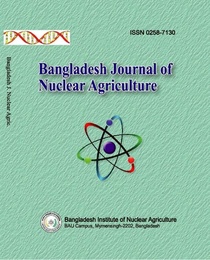YIELD GAP ANALYSIS OF OILSEED VARIETY BINASARISHA-9 IN SOME SELECTED AREAS OF BANGLADESH
Abstract
This study was conducted to analyze the yield gap of Binasarisha-9 producing farmers in Rangpur, Mymensingh, Sherpur, Gopalganj and Sunamganj districts of Bangladesh. Primary data were collected from 200 Binasarisha-9 producing farmers through pre-designed interview schedule during April-May, 2021 for achieving the purposes. Descriptive statistical techniques as well as Zandstra method and Cobb-Douglas production function were chosen to determine the yield gap and factors affecting yield of Binasarisha-9 production. The results showed that the estimated average yield gap-I was 0.07 t ha-1 (4.11 %) and average yield gap-II was 0.18 t ha-1 (12.35 %.). The lowest gap was observed in Mymensingh district (0.19 t ha-1 (12.22%) and it was the highest in Gopalganj district (0.31 t ha-1 (19.98%). The average total yield gap was 0.25 t ha-1 (16.47%) and there was much scope for yield enhancement in the variety. Most of the factors namely, human labour cost, power tiller cost, seed cost, fertilizer cost, irrigation cost and insecticides cost were statistically significant and positive. The yield gap is mainly caused by biological, socio-economic, climate and institutional/policy related factors. Different strategies, such as integrated crop management (1CM) practices, timely supply of inputs including credit to farmers, research and extension collaboration to transfer the new technologies have been discussed as strategies to minimize yield gap. Suggestions have been made to make credit available to farmers to buy necessary inputs. Reducing transaction cost, simplifying lending procedures and strengthening monitoring mechanism of the present credit system are, however, essential to enable the farmers to benefit the credit facility. Efforts should be made to update farmers’ knowledge on the causes of yield gap in Binasarisha-9 and measures to narrow the gap through training, demonstrations, field visits and monitoring by extension agencies to achieve high yield.
References
Aggarwal, P.K., K.B. Hebbar, M.V. Venugopalan, S. Rani, A. Bala, A. Biswal and S.P. Wani. 2008. Quantification of yield gaps in rainfed rice, wheat, cotton and mustard in India. ICRISAT. Global theme on Agro-ecosystems report # 43.
Alam, M.S. and M. Hossain, 1998. Farmers' perceptions of yield gaps, production losses and priority research problem areas in Bangladesh. Bangladesh. J. Agric. Econs., XXI: 21-38.
Alam, M. 2006. Factors affecting yield gap and efficiency in rice productions in some selected areas of Bangladesh. A thesis submitted for the degree of Ph.D. Dept. of Economics, Jahangir Nagar University, Bangladesh.
Bangladesh Bank. 2020. Category-wise import payments. https://www.bb.org.bd/econdata. Accessed 6th June, 2020.
Bangladesh Bureau of Statistics. 2019. Yearbook of Agricultural Statistics of Bangladesh 2019. http://www.bbs.gov.bd /site/page. Accessed 5th June, 2020.
Boomiraj, K., Chakrabarti, B., Aggarwal, P.K., Choudhary, R. and Chander, S. 2010. Assessing the vulnerability of Indian mustard to climate change. Agriculture, Ecosystems and Environment, 138:265-273.
FAO. 2018. Food and Agricultural Organization of the United Nations. Food and Agricultural Commodities Production, FAO STAT. Accessed 6th June, 2020.
Ghosh, R.K. and Chatterjee, B.N. 1988. Effect of date of sowing on the productivity of Indian mustard (Brassica juncea subsp. juncea) in the short and mild winter of the Gangeticplains of West Bengal. Indian Journal of Agricultural Sciences, 58(8): 589-596.
Matin, M.A, A.S.M. Anwarul Huq, M.S. Hussain, Md. Ruhul Karim and Elahi Baksh. 1996. Farm level yield analysis of tomato cultivation in selected areas of Bangladesh: An economic profile. Bangladesh J. Agric. Res. 21 (1).
OFRD (Annual report, BARI), 2003-2004a. Yield gap analysis of wheat under different management situation at MLT site, Palashbari, Rangpur.
OFRD (Annual report, BARI), 2003-2004b.Yield gap analysis of chickpea under different management situation at Nachole, Chapainawabgonj.
OFRD (Annual report, BARI), 2008-2009. Yield gap analysis of mustard in the farmer’s fields. BARI report, Dhaka.
RAP (Regional Office for Asia and the Pacific). 1999. Report of the expert consultation on bridging rice yield gap in the Asia-Pacific region. FAO.
Roy, Indrajit.1997. Stagnating productivity in crop agriculture. The quest for sources of growth. Environment and agricultural productivity in Bangladesh. Bangladesh Academy of Agriculture (BAAG).
Siddiq, E.A. 2000. Bridging rice yield gap in India. In: Proceedings of Expert Conference on bridging the rice yield gap in the Asia- Pacific region, RAP, FAO.
Zandstra, H.G., Price, E.C., Litsinger, J.A. and Morris, R.A. 1981. A Methodology for On-Farm Cropping Systems Research. IRRI, Manila, 147 p.
-
Download



